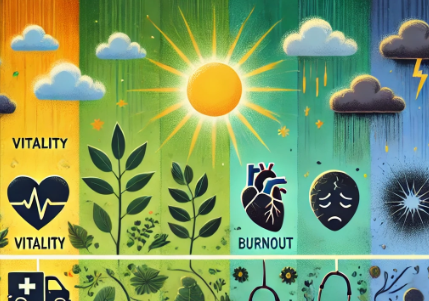Notifications


Day 1: Where Do You Stand on the Vitality-Burnout Continuum?
I clearly remember the sound of the car’s tires screeching as it skidded toward mine, narrowly avoiding a crash. With my 3-year-old son in the car, that moment became a vivid wake-up call. I was operating on autopilot—exhausted, mentally foggy, and living in a state of constant burnout. That near-miss made me realize I couldn’t continue down that path.
At 33 years old, I was dealing with high blood pressure, daily palpitations, mood swings, and insomnia. I was constantly stressed, running between the hospital and my private practice, but nothing seemed to work. I didn’t know the term "burnout" yet, but I felt it deeply. It took time to seek answers. The breakthrough came during a wellness conference when I participated in an exercise asking, "Why do I need good health?" Something shifted within me, sparking a new perspective and setting me on a path to reclaim my vitality. This journey has not been without sacrifices, such as closing my business, but it was necessary to recalibrate. Many doctors, though, continue to feel the constant pressure of work intensifying every year. The effects of the pandemic only added more strain.
You’ve probably heard the term "provider" used often in healthcare. But can we truly provide if we’re running on empty? It’s a question we must all ask ourselves. Can we truly care for others if our own well-being is suffering?

What is Health and Vitality? What is Burnout?
We’re familiar with the WHO definition of health: “A state of complete physical, mental, and social well-being, and not merely the absence of disease.” However, for most physicians, this is idealistic. Our work tends to focus primarily on diagnosing and treating physical illnesses, while the deeper aspects of mental and social health are often neglected—both for our patients and for ourselves.
Vitality, on the other hand, is essential. It can be described as “having the capacity to live and grow, or physical or mental energy or strength.” Think of it like a bank account—you either have a surplus of vitality or you’re in a deficit, and when the latter happens, you enter burnout territory.
Take a Moment of Reflection: Have You Ever Experienced Signs of Extreme Fatigue, Depersonalization, or a Sense of Reduced Personal Accomplishments?
These are three major symptoms of burnout. Burnout is a pervasive global issue in healthcare, impacting work efficiency, job satisfaction, and patient care. As doctors, we often experience emotional exhaustion, especially during tough shifts. The difference between burnout and stress is the inability to recover—burnout lingers even after time off.
So, burnout has three primary symptoms:
Burnout isn’t just fatigue from working hard—it’s chronic exhaustion that affects all areas of your life, including your relationships and your ability to connect with patients.
Burnout is Not Just Fatigue from Working Hard
Here’s the difference: Imagine you take time off to recharge. You rest, sleep, and relax—but when you return to work, you still feel emotionally drained, almost as if you never really rested. Why does this happen?
Burnout isn’t just physical exhaustion—it affects your entire system: body, emotions, and spirit. When your energy accounts—physical, emotional, and spiritual—are depleted, recovery doesn’t happen unless you specifically target and replenish each one.
Burnout Can Affect Doctors in All Areas of Life
Burnout doesn’t only impact your work—it affects your family, your relationships, and your personal well-being. Physically and emotionally drained physicians often find themselves more irritable at home, leading to conflicts with spouses and children. Furthermore, burnout significantly impacts patient care, leading to errors, suboptimal outcomes, and reduced patient satisfaction.
What Percentage of Doctors Are Experiencing Burnout?
While everyone is excited to talk about Burnout as a phenomenon or general topic (like global warming or the weather forecast), at the same time, there is hesitancy to "really talk about it" as a silent pandemic among healthcare workers, especially after the COVID-19 era. Burnout is very real and not obviously visible due to the silent taboo of this topic between doctors. Therefore, many doctors are burning silently after another stressful, long day.
Let's look at the official statistics:


At our physician community, we believe in the power of purpose-driven connection.
This is more than just a network — it’s a movement to restore the excitement of the white coat. It’s a space where doctors from all specialties come together to share ideas, support one another, and spark meaningful change in healthcare.
We are united by a desire to reignite the passion that brought us into medicine — to find joy and fulfillment in our work again. Here, wellness isn’t just something we promote for our patients, but something we cultivate for ourselves. It’s a place to reconnect with purpose, rediscover your voice, and feel the strength that comes from a community of like-minded peers.
Together, we’re shaping the future of medicine — innovating, collaborating, and leading with integrity, compassion, and resilience. This is where doctors come to grow — as clinicians, as leaders, and as human beings.
Let’s bring back the spark. Let’s wear the white coat with pride — and with power. 6524bb9